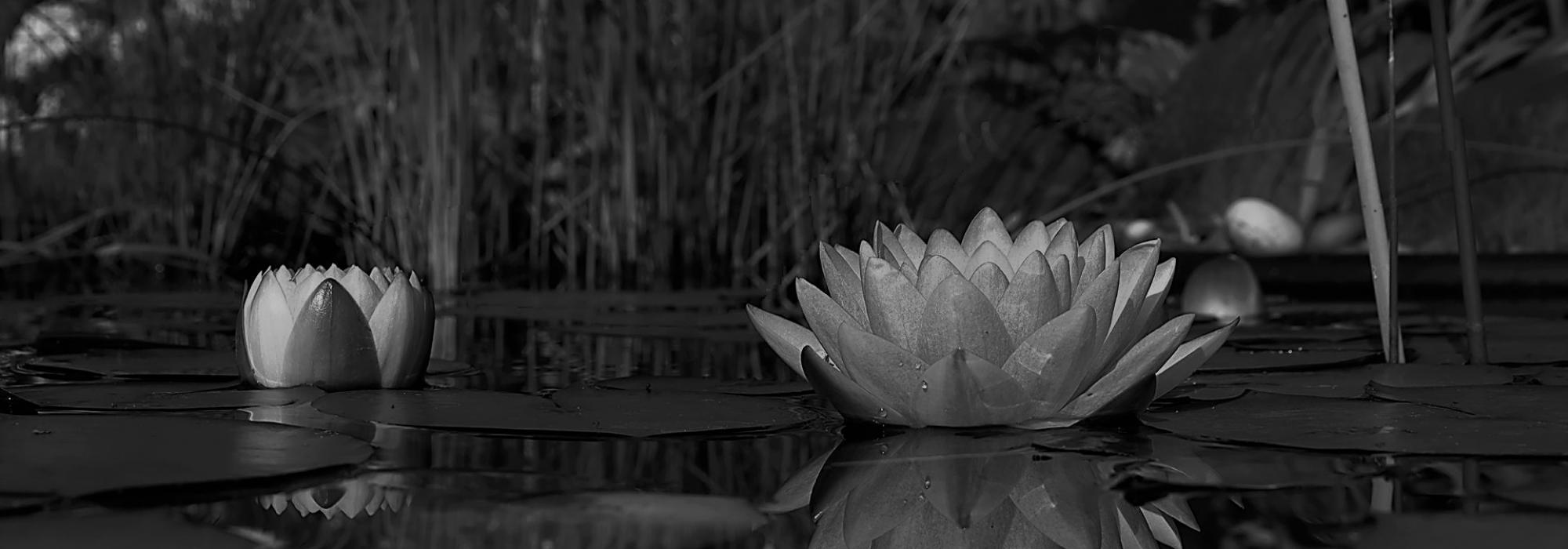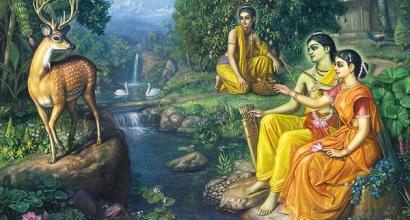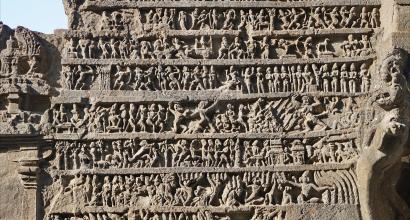Dvyavadhānam
Regardless of the number of questioners, Avadhānam involves just two components. The performer must thus concentrate on only two things at once. Psychology, which asserts that the human mind, however sharp, can at best concentrate on two things simultaneously, corroborates this stand. In all two-pronged activities that progress simultaneously, one is important and the other, (relatively) unimportant. In Avadhānam, the important activity unfolds in the performer’s mind, while the unimportant one proceeds outside.
The repartee between the aprastuta-prasaṅgī and avadhānī is external; thinking of solutions to all kinds of literary challenges is internal. When the questioners of ghaṇṭā-gaṇana, vyastākṣarī, uddiṣṭākṣarī, and sankhyā-bandha interject, the performer temporarily stalls his internal activity, answers their questions, and resumes his thoughts of solving challenges. Sūcī-kaṭāha-nyāya[1] (the maxim of the needle and the boiler) illustrates this best. Solving challenges such as samasyā and datta-padī is like fabricating a boiler. In this process, chatting with the aprastuta-prasaṅgī is akin to producing a needle. Just like a blacksmith swiftly fashions a needle and resumes the production of the boiler, the performer crosses the hurdles of the said components and resumes versification. He does so without ever losing his internal composure and external cheerfulness. The main idea is to make a distinction (pariccheda) between the inner and outer quarters. Svāmī Vidyāraṇya explains this through an example:
Despite her household duties, a [married] woman is always lost in thoughts of dalliance with her paramour. But she does not altogether ignore the chores; she attends to them only cursorily.[2]
In its highest reaches, pariccheda of this kind defines scholarship: “Paricchedo hi pāṇḍityam.”[3] D V Gundappa remarks in his Maṅkutimmana Kagga:
Build two rooms in the home of your mind
In the outer room, play the worldly games
In the silent inner room, relax alone in peace
This is the principle of the great yoga.[4]
A person who is not alert and calm can never become a successful performer. During a performance, maintaining the alpha-rhythm state of the brain is essential, because inhibitory cells act like doorkeepers and help filter out unwanted information. This is closely related to the conception of avadhāna-samādhi / sārasvata-muhūrta. In this regard, it is instructive to read through a passage written by Arthur Conan Doyle:
I consider that a man’s brain originally is like a little empty attic, and you have to stock it with such furniture as you choose. A fool takes in all the lumber of every sort that he comes across, so that the knowledge which might be useful to him gets crowded out, or at best is jumbled up with a lot of other things, so that he has a difficulty in laying his hands upon it. Now the skilful workman is very careful indeed as to what he takes into his brain-attic. He will have nothing but the tools which may help him in doing his work, but of these he has a large assortment, and all in the most perfect order. It is a mistake to think that that little room has elastic walls and can distend to any extent. Depend upon it there comes a time when for every addition of knowledge you forget something that you knew before. It is of the highest importance, therefore, not to have useless facts elbowing out the useful ones.[5]
Indeed, the mind is similar to a fort that has numerous attributes of order. Bhagavat-pāda Śaṅkara says:
गाम्भीर्यं परिखास्पदं घनधृतिः प्राकार उद्यद्गुण-
स्तोमश्चाप्तबलं घनेन्द्रियचयो द्वाराणि देहे स्थितः।
विद्यावस्तुसमृद्धिरित्यखिलसामग्रीसमेते सदा
दुर्गातिप्रियदेव मामकमनोदुर्गे निवासं कुरु॥[6]
O Śiva, please dwell in the fort of my mind: It is rich with knowledge and has depth as moat, steadfastness as walls, virtues as army, and sense organs as doors.
A recent research article, though intended in a different context, admirably relates to our art form and the role of constraints in it:
The larger lesson is that the brain is a neural tangle of near infinite possibility, which means that it spends a lot of time and energy choosing what not to notice. As a result, creativity is traded away for efficiency; we think in literal prose, not symbolist poetry. And this is why constraints are so important: It’s not until we encounter an unexpected hindrance – a challenge we can't easily resolve – that the chains of cognition are loosened, giving us newfound access to the weird connections simmering in the unconscious. Here are the scientists:
Consistently, these studies show that encountering an obstacle in one task can elicit a more global, Gestalt-like processing style that automatically carries over to unrelated tasks, leading people to broaden their perception, open up mental categories, and improve at integrating seemingly unrelated concepts.
… The artificial requirements of the sonnet are just another cognitive obstacle, a hurdle that compels the mind to think in a more holistic fashion. Unless poets are stumped by their art, unless they are forced to look beyond the obvious associations, they’ll never invent an original line. They’ll be stuck with clichés and banalities, with predictable adjectives and boring verbs. And this helps explain the stubborn endurance of poetic forms: because poets need to find a rhyming word with exactly three syllables, or an adjective that fits the iambic scheme, they end up uncovering all sorts of unexpected associations. As Paul Valery declared: “A person is a poet if his imagination is stimulated by the difficulties inherent in his art and not if his imagination is dulled by them.
We break out of the box by stepping into shackles.”[7]
Modern Techniques to Improve Memory
In his far-famed book How to Develop A Good Memory: for Names, Faces and Facts, Robert H Nutt propounds his theory on ‘The Mental Filing System,’ a technique to remember a list of hundred objects. He instructs the readers on the process to remember names and faces. This primarily involves creating a series of stories inside one’s own head, which will help put the objects in perspective. As far as Avadhānam is concerned, this technique is not helpful, for it further burdens the performer’s already-overworked brain. The performer’s prime objective is to remember verses and he is on the lookout for a technique that helps him do this better. The present method expects him to create and remember multiple stories, which might help him recall verses! A demonstrably roundabout exercise, this offers little help.
Another method to improve memory, which has come to the forefront in recent times, is called the ‘Memory Palace.’ This, too, is not useful in the present context for similar reasons as enlisted above.
Other techniques expect us to modify the object of memory in some way: exaggerate, take it to its [logical] extremity, abnormalize, associate it with ridiculous or illogical things, identify an internal logic, picturize, personalize, associate it with known things, activate, habitize, unconventionalize, convert it into a song or verse, translate it into an altogether unusual form etc. While most of these might work in regular scenarios, only some of them help in Avadhānam.
Purely literary factors such as metrical rhythm, compounds, figures of sound, and unique features of the topic help the performer to remember verses. As observed previously, the performer finds it easy to recall a verse upon looking at the questioner’s face. Apart from these, no other generalized technique is of great help. This is because memory is itself a personal feature—one must find a way that works best for him / her. Going behind techniques to bolster memory often takes us away from the objective. Therefore, one must hone memory through practices aligned to one’s own proclivities. We will all do well to pay heed to Eustace H Miles, who said: “Don’t apply any system if you can do without it. Do not apply any system if it does not suit you as an individual.”[8]
Poets are usually thought of as possessing good associative memory. I A Richards, the well-known literary critic, says: “Poets are distinguished from other men … by the greater richness and associative power of their subconscious memories” [9] Since the performer is primarily a poet, he has all the characteristics that mark a poet. Stephen Spender says:
… Memory is the root of creative genius. It enables the poet to connect the immediate moment of perception, which is often called ‘inspiration,’ with past moments in which he has received like impressions. This relating of the immediate impressions with past ones enables the poet, through the moment, to strike a kind of chord across time … The quality of a poet’s memory, and the way in which he uses it, are what chiefly distinguishes him from other poets. There are two main categories of memory: one is what might be called overt and conscious memory, the other is hidden and unconscious. Overt and conscious memory is memory of impressions which at the time of other being experienced have been formulated in the mind as ideas. Hidden and unconscious memory is memory of impressions which have not been consciously formulated when they were experienced, so that remembering is like creating them anew, or like experiencing them for the first time. If the art of concentrating in a particular way is the discipline necessary for poetry to reveal itself, memory exercised in a particular way is the natural gift of poetic genius. The poet, above all else, is a person who never forgets certain sense-impressions which he has exercised and which he can relive again and again as though with all their original freshness … It is perhaps true to say that memory is the faculty of poetry, because the imagination itself is an exercise of memory. There is nothing we imagine which we do not already know. And or ability to imagine is our ability to remember what we have already once experienced, and to apply it to some different situation. Thus the great poets are those with memories so great that they extend beyond their strongest experiences to their minute observations of people and things far outside their own self-centredness. [10]
Eka-sandhā-grahaṇa
A person capable of retaining in memory absolutely anything by listening to it just once is termed eka-sandhā-grāhī / eka-sandhi-grāhī / eka-pāṭhī. If a person can accomplish the same feat by listening twice or thrice, he is termed dvi-sandhā-grāhī / tri-sandhā-grāhī and so on. Typically, this is a congenital skill, and people who possess it exist even to this day, although in small numbers.
Indian tradition informs us that people such as Śaṅkara, Kurattāḻvār, Ānanda-tīrtha, Śrī-harṣa and Jagannātha had this skill. Māḍabhūṣi Veṅkaṭācārya, Caḻlapiḻla Veṅkaṭa-śāstrī, and Pisupāṭi Cidambara-śāstrī were eka-sandhā-grāhīs. This is a recorded fact. Western equivalents include Lucius Annaeus Seneca, Thomas Babington Macaulay, and Henri de Blowitz.
This skill comes with a set of limitations. The subject to be remembered must have the following qualities: it must not be obscure; it should be clearly expressed in a straightforward manner, using simple and well-known words.
A couple of literary anecdotes illustrate this well:
Pratāpa-rudra was the last ruler of the Kakatiya dynasty. Warangal was his capital. Three poets popular by the titles eka-daṇḍī, dvi-daṇḍī, and tri-daṇḍī were the prized possessions of his court. They claimed to retain in memory absolutely anything by listening to the subject merely once, twice, and thrice, respectively. Whenever a poet from a different province came to Pratāpa-rudra looking for patronage, this triumvirate would make sure he went back empty-handed. To this end they devised the following scheme: they would ask him to recite his composition; eka-daṇḍī would immediately repeat it; listening to the poet and eka-daṇḍī recite it, dvi-daṇḍī would do the same; then followed tri-daṇḍī. This naturally led the king to think that the person looking for patronage is guilty of plagiarism, an act unthinkable for poets. The poor poet would then be either punished or sent out unceremoniously.
This news spread far and wide and reached Rāghavāṅka, the Kannada poet who inaugurated the genre of Ṣatpadī-kāvya. Wanting to teach a lesson to the ignoble triad of poets, he composed Vireśa-caritè in Uddaṇḍa-ṣaṭpadī, a metre of his own creation. This metre has the same number of mātrās as the well-known Vārdhaka-ṣaṭpadī, but the way in which they are grouped under gaṇas is different. Reciting a verse composed in this metre is itself a challenge, and this gives it an unfathomable twist. Thanks to this metrical nuance, the ill-willed poets of the king’s court could not remember Rāghavāṅka’s composition.
There is another story of the same sort that involves Bhoja and Kāli-dāsa. It seems Kāli-dāsa composed a verse that is impossible for anyone to grasp at one go, and posed it as a challenge to people who claimed to do it:
वाश्चारेड्ध्वजभिद्धृतोड्वधिपतिः कुध्रेड्जजानिर्गणे-
ड्गोराडारुडुरस्सरेडुरुतरग्रैवेयकब्राडरम्।
उड्वीड्रुङ्नरकास्थिधृक्त्रिदृगिभेडार्द्राजिनाच्छच्छदः
स स्यादम्बुमदम्बुदालिगलरुग्देवो मुदे वो भवः॥
The poor poets could hardly read this out loud. While this verse is challenging at the level of sound, the English passage we quote next is challenging at the level of sense.
Samuel Foote once composed a nonsense-passage to test Charles Macklin, who claimed that he could repeat anything after hearing it once. The passage is titled Grand Panjandrum and is as follows:
So she went into the garden to cut a cabbage leaf, to make an apple pie; and at the same time a great she-bear coming up the street, pops its head into the shop. What! No soap? So he died, and she very imprudently married the barber; and there were present the Picninnies, and the Joblillies, and the Garyulies, and the grand Panjandrum himself, with the little round button at top; and they all fell to playing the game of catch as catch can, till the gunpowder ran out at the heels of their boots.
Macklin obviously accepted defeat.
Conclusion
Avadhānam is not a platform to either exhibit or test immaculate memory. Retention, here, is only a part of the overall poetic process, and is not an entity that deserves independent attention. The performer’s erudition, creative imagination, and a sensitive feel for the world are elements that augment memory. Dry scholars can never become successful performers of this art. Nor can masters of memory techniques. This does not mean the performer must be bereft of special skills; he should utilize them all to enhance his extempore poetry. In a nutshell, the performer’s concentration propped up by his management of dvyavadhānam is of supreme significance in Avadhānam.
[1] Ref: Laukika-nyāyāñjaliḥ: A Handful of Popular Maxims
[2] परव्यसनिनी नारी व्यग्रापि गृहकर्मणि।
तदेवास्वादयत्यन्तः परसङ्गरसायनम्॥
परसङ्गं स्वादयन्त्या अपि नो गृहकर्म तत्।
कुण्ठीभवेदपि त्वेतदापातेनैव वर्तते॥ (Vedānta-pañcadaśī, 9.84–85)
[3] Hitopadeśa, 1.148
[4] èraḍu koṇègaḻa nīṃ māḍu manadālayadi
hòragoṇeyali logarāṭagaḻanāḍu।
viramisòbbane maunadòḻamanèya śāntiyali
varayogasūtravidu maṃkutimma॥ (701) Ref: Foggy Fool’s Farrago
[5] The Penguin Complete Sherlock Holmes (A Study in Scarlet), p. 21
[6] Śivānanda-laharī, verse #42
[7] Ref: Lehrer, Jonah. Need to Create? Get a Constraint. <https://www.wired.com/2011/11/need-to-create-get-a-constraint/>
[8] Ref: How to Remember: Without Memory Systems or With Them
[9] Quoted in: The World of Poetry, p. 209
[10] The Making of a Poem, p. 23
Concluded.
















































